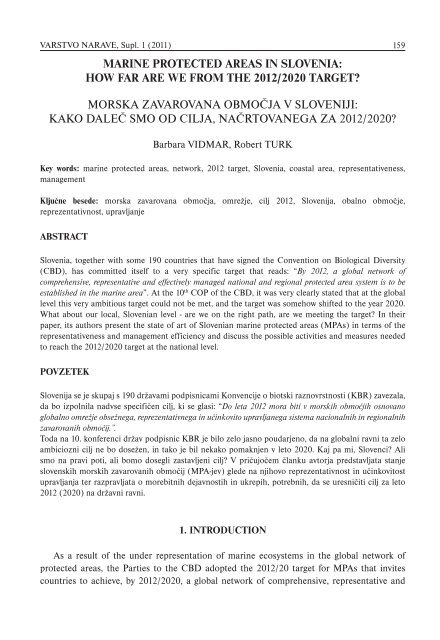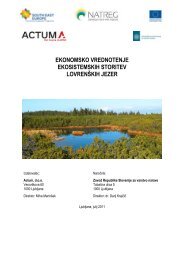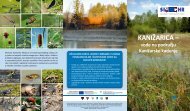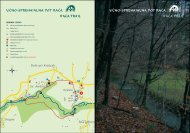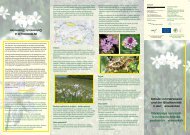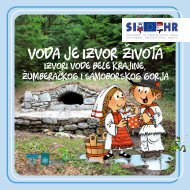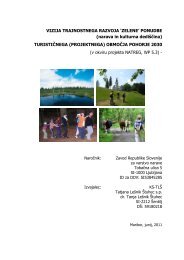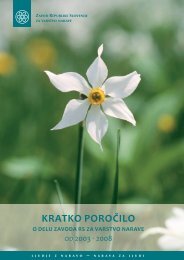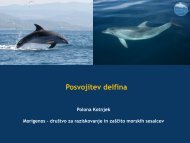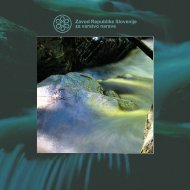marine protected areas in slovenia - Zavod RS za varstvo narave
marine protected areas in slovenia - Zavod RS za varstvo narave
marine protected areas in slovenia - Zavod RS za varstvo narave
You also want an ePaper? Increase the reach of your titles
YUMPU automatically turns print PDFs into web optimized ePapers that Google loves.
VA<strong>RS</strong>TVO NARAVE, Supl. 1 (2011)MARINE PROTECTED AREAS IN SLOVENIA:HOW FAR ARE WE FROM THE 2012/2020 TARGET?159MO<strong>RS</strong>KA ZAVAROVANA OBMOČJA V SLOVENIJI:KAKO DALEČ SMO OD CILJA, NAČRTOVANEGA ZA 2012/2020?Barbara VIDMAR, Robert TURKKey words: <strong>mar<strong>in</strong>e</strong> <strong>protected</strong> <strong>areas</strong>, network, 2012 target, Slovenia, coastal area, representativeness,managementKljučne besede: morska <strong>za</strong>varovana območja, omrežje, cilj 2012, Slovenija, obalno območje,reprezentativnost, upravljanjeABSTRACTSlovenia, together with some 190 countries that have signed the Convention on Biological Diversity(CBD), has committed itself to a very specific target that reads: “By 2012, a global network ofcomprehensive, representative and effectively managed national and regional <strong>protected</strong> area system is to beestablished <strong>in</strong> the <strong>mar<strong>in</strong>e</strong> area”. At the 10 th COP of the CBD, it was very clearly stated that at the globallevel this very ambitious target could not be met, and the target was somehow shifted to the year 2020.What about our local, Slovenian level - are we on the right path, are we meet<strong>in</strong>g the target? In theirpaper, its authors present the state of art of Slovenian <strong>mar<strong>in</strong>e</strong> <strong>protected</strong> <strong>areas</strong> (MPAs) <strong>in</strong> terms of therepresentativeness and management efficiency and discuss the possible activities and measures neededto reach the 2012/2020 target at the national level.POVZETEKSlovenija se je skupaj s 190 državami podpisnicami Konvencije o biotski raznovrstnosti (KBR) <strong>za</strong>ve<strong>za</strong>la,da bo izpolnila nadvse specifičen cilj, ki se glasi: “Do leta 2012 mora biti v morskih območjih osnovanoglobalno omrežje obsežnega, reprezentativnega <strong>in</strong> uč<strong>in</strong>kovito upravljanega sistema nacionalnih <strong>in</strong> regionalnih<strong>za</strong>varovanih območij.”.Toda na 10. konferenci držav podpisnic KBR je bilo zelo jasno poudarjeno, da na globalni ravni ta zeloambiciozni cilj ne bo dosežen, <strong>in</strong> tako je bil nekako pomaknjen v leto 2020. Kaj pa mi, Slovenci? Alismo na pravi poti, ali bomo dosegli <strong>za</strong>stavljeni cilj? V pričujočem članku avtorja predstavljata stanjeslovenskih morskih <strong>za</strong>varovanih območij (MPA-jev) glede na njihovo reprezentativnost <strong>in</strong> uč<strong>in</strong>kovitostupravljanja ter razpravljata o morebitnih dejavnostih <strong>in</strong> ukrepih, potrebnih, da se uresničiti cilj <strong>za</strong> leto2012 (2020) na državni ravni.1. INTRODUCTIONAs a result of the under representation of <strong>mar<strong>in</strong>e</strong> ecosystems <strong>in</strong> the global network of<strong>protected</strong> <strong>areas</strong>, the Parties to the CBD adopted the 2012/20 target for MPAs that <strong>in</strong>vitescountries to achieve, by 2012/2020, a global network of comprehensive, representative and
VA<strong>RS</strong>TVO NARAVE, Supl. 1 (2011)natural heritage sites (governmental decree “Uredba o določitvi <strong>in</strong> varstvu naravnih vrednot,Off. Bull. 111/04, 70/06, 58/09 <strong>in</strong> 93/10) as well as the conservation of biodiversity throughthe protection of endangered animal and plant species (governmental decrees “Uredba o<strong>za</strong>varovanih prostoživečih rastl<strong>in</strong>skih vrstah and Uredba o <strong>za</strong>varovanih prostoživečih živalskihvrstah, Off. Bull.46/2004) through ecologically important <strong>areas</strong> (governmental decree “Uredbao ekološko pomembnih območjih”, Off. Bull. 48/04 ) and follow<strong>in</strong>g the Habitat Directive,especially through Natura 2000 sites (governmental decree” Uredba o posebnih varstvenihobmočjih, območjih Natura 2000, Off. Bull. 49/04, 110/04, 59/07 <strong>in</strong> 43/08).1612010200920042002200120001998management body for Strunjanmanagement body for SečovljeSečovlje - renewed legislation (govem mental decree)Škocjan Inlet <strong>protected</strong> (state law)19911990Debeli rtič - municipality decreeSečovlje, Strunjan, Rt Madona - municipality decrees1985<strong>in</strong>ventory of coastal natural heritage1980Figure 1: Slovenian coastal and <strong>mar<strong>in</strong>e</strong> PA’s milestonesSlika 1: Slovenski mejniki <strong>za</strong> obalna <strong>in</strong> morska <strong>za</strong>varovana območja2.2 AREAS AND SITES OF CONSERVATION INTEREST ALONG THESLOVENIAN COASTWith the term Areas of Conservation Interest we are encompass<strong>in</strong>g not only <strong>mar<strong>in</strong>e</strong>and coastal <strong>protected</strong> <strong>areas</strong> but also other <strong>areas</strong> and sites, which accord<strong>in</strong>g to the NatureConservation Act are important <strong>in</strong> terms of protection of valuable natural features, or <strong>in</strong> termsof biodiversity conservation or both. They can thus be s<strong>in</strong>gle valuable natural features, habitatsof endangered species, ecologically important <strong>areas</strong>, Natura 2000 sites, or <strong>protected</strong> <strong>areas</strong>.They all benefit from a certa<strong>in</strong> degree of legal protection and general conservation measures.
162 Barbara Vidmar, Robert Turk: Mar<strong>in</strong>e <strong>protected</strong> <strong>areas</strong> <strong>in</strong> Slovenia: ...It is, however, only <strong>in</strong> the case of <strong>protected</strong> <strong>areas</strong> that concrete conservation measures are<strong>in</strong>cluded <strong>in</strong> the legal act, with which the s<strong>in</strong>gle <strong>protected</strong> area is established.The Slovenian coastal area is, <strong>in</strong> spite of its shortness, very rich <strong>in</strong> terms of biologicaland landscape diversity. Its natural characteristics comprise a great diversity of habitat types,animal and plant species and ecosystems scattered between the rocky shore and its flyschcliffs, the alluvial pla<strong>in</strong>s with wetlands, coastal lagoons and salt-pans and the shallow watersof the Slovenian sea.2.2.1 Valuable natural featuresIn the Nature Conservation Act, valuable natural features (assets) are def<strong>in</strong>ed as rare,valuable or well-known natural phenomena, or any other valuable phenomena, componentsor parts of the liv<strong>in</strong>g or non-liv<strong>in</strong>g nature, nature area or part thereof, an ecosystem, naturalor cultural landscape. In particular, they can be geological phenomena, m<strong>in</strong>erals and fossilsor m<strong>in</strong>eral and fossil sites, surface and subsurface karst features, caves, gorges and othergeomorphological phenomena, glaciers and glacial forms, spr<strong>in</strong>gs, waterfalls, rapids, lakes,bogs, brooks and rivers, river banks, sea-shore, plant and animal species and exceptionalspecimens and habitats thereof, ecosystems, etc.Most of the valuable natural features <strong>in</strong> the narrow coastal strip are on one hand l<strong>in</strong>ked togeomorphology and the great diversity of geomorphological phenomena of the flysch cliffsand, on the other hand, on endangered habitat types and habitats of endangered species. Bothparks – Sečovlje and Strunjan (Fig. 2) – are among the <strong>areas</strong> where the density of valuablenatural features is the greatest.Figure 2: Valuable natural features <strong>in</strong>side Strunjan Natural ReserveSlika 2: Dragocena naravna dedišč<strong>in</strong>a v Naravnem rezervatu Strunjan
VA<strong>RS</strong>TVO NARAVE, Supl. 1 (2011)2.2.2 Ecologically Important Areas and Natura 2000 sites163Accord<strong>in</strong>g to the Nature Conservation Act, Ecologically Important Areas are def<strong>in</strong>edas <strong>areas</strong> of a habitat type, its part or large ecosystem units, which significantly contributeto biodiversity conservation. They represent the key <strong>areas</strong> <strong>in</strong> terms of biodiversity at thenational level. The great diversity of coastal area is reflected <strong>in</strong> a number of EcologicallyImportant Areas: Zaliv Sv. Jerneja, Debeli rtič, Debeli rtič-Valdoltra, Sv. Nikolaj, Škocjanski<strong>za</strong>tok, Žusterna, Žusterna – Izola, Strunjanski klif, Strunjanske sol<strong>in</strong>e s Stjužo, Pacug – Fiesa,Strunjan – Pacug, Piranski klif, Rt Madona and Sečoveljske sol<strong>in</strong>e s Sečo and, last but not least,the Slovenian sea. They encompass habitats of endangered animal and plant species – birds<strong>in</strong> Škocjanski <strong>za</strong>tok or Sečoveljske sol<strong>in</strong>e or L<strong>in</strong>um maritimum <strong>in</strong> Sv. Nikolaj and endangeredhabitat types, as it is the case of the Posidonia oceanic meadow at Žusterna.As it could be expected, most of the Ecologically Important Areas, mentioned above,turned out to be important not only at the national level but also for the conservation ofEuropean biodiversity. Accord<strong>in</strong>g to the Birds and Habitat Directives, almost all of them, theonly exception be<strong>in</strong>g Zaliv sv. Jerneja, were declared <strong>in</strong> 2004 Special Areas of Conservation(SAC) or/and Specially Protected Areas (SPA). They encompass a wide range of <strong>mar<strong>in</strong>e</strong> andcoastal habitat types and species (see Table 1); the list, however, is not complete yet. Data arebe<strong>in</strong>g gathered <strong>in</strong> order to def<strong>in</strong>e <strong>in</strong> the near future SAC for two important <strong>mar<strong>in</strong>e</strong> species – theBottlenose Dolph<strong>in</strong> and the Loggerhead Turtle.2.2.3 Mar<strong>in</strong>e and coastal <strong>protected</strong> <strong>areas</strong>To all the <strong>areas</strong> and sites, listed as Valuable Natural Features, Ecologically Important Areasor Natura 2000 sites, a certa<strong>in</strong> degree of general protection and even management <strong>in</strong> thecase of Natura 2000 sites should be granted <strong>in</strong> the process of physical plann<strong>in</strong>g, throughenvironmental impact assessments, build<strong>in</strong>g permits, etc. However, when concrete issues arediscussed numerous gaps occur <strong>in</strong> the general picture that prevent efficient protection. Theadvantage of <strong>protected</strong> <strong>areas</strong> lies <strong>in</strong> the fact that they have their own legal acts, which def<strong>in</strong>econservation measures, management, monitor<strong>in</strong>g and surveillance and thus leave less space to<strong>in</strong>consistency and mis<strong>in</strong>terpretation.There are five coastal and <strong>mar<strong>in</strong>e</strong> <strong>protected</strong> <strong>areas</strong> along the Slovenian coast. Two natureparks - Sečovlje Sal<strong>in</strong>a Nature Park 1 and Strunjan Nature Park, which embrace two naturereserves - Stjuža and Strunjan 2 , two natural monuments - Debeli rtič 3 and Rt Madona 4 and, lastbut not least, the Škocjan Inlet Natural Reserve 5 .1Piran Municipality decree <strong>in</strong> 1990, replaced by a governmental decree “Uredba o kraj<strong>in</strong>skem parku Sečoveljskesol<strong>in</strong>e” <strong>in</strong> 20012Piran and Izola Municipalities decrees <strong>in</strong> 1990, replaced by a governmental decree “Uredba o kraj<strong>in</strong>skem parkuStrunjan” <strong>in</strong> 20043Koper municipality decree “Odlok o razglasitvi naravnega spomenika Debeli rtič” from 19914Piran Municipality decree “Odlok o razglasitvi posameznih naravnih spomenikov <strong>in</strong> spomenikov oblikovane<strong>narave</strong> v obč<strong>in</strong>i Piran” from 19905governmental law “Zakon o naravnem rezervatu Škocjanski <strong>za</strong>tok” from 1998
164 Barbara Vidmar, Robert Turk: Mar<strong>in</strong>e <strong>protected</strong> <strong>areas</strong> <strong>in</strong> Slovenia: ...2.2.4 Habitat typesCliffs and mudflats 6 are the most representative habitat types along the Slovenian coastl<strong>in</strong>eand have been appropriately <strong>in</strong>cluded <strong>in</strong> the <strong>mar<strong>in</strong>e</strong> and coastal <strong>protected</strong> <strong>areas</strong> listed above.With<strong>in</strong> the Strunjan Nature Park and the Natural Monument Debeli rtič, we found the mostrepresentative cliffs on Slovenian coast. The only two lagoons (Stjuža – <strong>mar<strong>in</strong>e</strong> and ŠkocjanInlet - brackish) are also with<strong>in</strong> <strong>protected</strong> <strong>areas</strong> – Strunjan Nature Park and Škocjan InletNature Reserve. The situation <strong>in</strong> terms of sandbanks, Spart<strong>in</strong>a swards, Mediterranean saltmeadows, posidonia beds and reefs is less satisfy<strong>in</strong>g. So far, no <strong>protected</strong> <strong>areas</strong> have beenestablished for the conservation of these rare and endangered habitat types. Some proposalswere tabled concern<strong>in</strong>g the sandbank on the promontory Debeli rtič and the Spart<strong>in</strong>asward <strong>in</strong> the area of Sv. Jernej. Proposals for the establishment of <strong>protected</strong> <strong>areas</strong> shouldbe elaborated at least for the Mediterranean salt meadow of Sv. Nikolaj and the posidoniameadow at Žusterna and conservation measures proposed for the reef between Fiesa andStrunjan, the large sandbank Brajde outside Piran. The current situation concern<strong>in</strong>g habitattypes is presented <strong>in</strong> Table 1.Table 1: List of representative <strong>mar<strong>in</strong>e</strong> and coastal habitat types <strong>in</strong> SloveniaTabela 1: Seznam reprezentativnih morskih <strong>in</strong> obalnih habitatnih tipov v SlovenijiName and FFH codeVegetated sea cliffs of the Mediterraneancoasts with endemic Limonium ssp. 1240Sandbanks which are slightly andpermanently covered by seawater 1110Legal protection(112/2003)Presence <strong>in</strong>pSACsPresence <strong>in</strong>MPAs?YES YES YES(Debeli rtič,Strunjan)NO (Valdoltra, Fiesa;Piran.....)NO Proposed YES (Debeli rtič) /NO (Brajde)Conservationstatus☺Sea grass meadows with Cimodocea not ffh YES - YES ☺Sea grass meadows with Zoostera mar<strong>in</strong>a NO YES (notNOsufficient)Sea grass meadows with Zoostera noltii NO YES (not YES (NR Strunjan) sufficient)Algal beds (Cystoseira) not ffh YES - YES ☺Spart<strong>in</strong>a swards (Spart<strong>in</strong>ion maritimae)1320YES YES and NO YES(SečovljeSaltpans)NO (Sv. Jernej bay)Mediterranean salt meadows (Juncetaliamaritimi) 1410Mudflats and sandflats not covered byseawater at low tide1140Salicornia and other annuals coloniz<strong>in</strong>gmud and sand 1310YES YES YES and NO (St. Nikolaj)YES YES YES (majority) ☺YES YES YES ☺Annual vegetation on drift l<strong>in</strong>es 1210 NO YES YES ☺6 Natura 2000 codes: 1240, 1140, 1310 and 1210
VA<strong>RS</strong>TVO NARAVE, Supl. 1 (2011)165Name and FFH codeLegal protection(112/2003)Presence <strong>in</strong>MPAs?Presence <strong>in</strong>MPAs?ConservationstatusPosidonia beds (Posidonion oceanicae)* YES YES NO 1120Reefs 1170 NO NO NO Coastal lagoons*1150 YES YES YES 100% ☺☺2.2.5 SpeciesThe protection of species is often one of the ma<strong>in</strong> goals of <strong>protected</strong> <strong>areas</strong>. Some of therare and endangered species present <strong>in</strong> the Slovenian coastal area are shown <strong>in</strong> Table 2,together with their presence with<strong>in</strong> s<strong>in</strong>gle coastal and <strong>mar<strong>in</strong>e</strong> <strong>protected</strong> <strong>areas</strong>. The situationlooks fairly good; however, when we focus on <strong>mar<strong>in</strong>e</strong> <strong>areas</strong>, it is clear that due to their limitedsize they alone cannot guarantee good conservation status of the listed species <strong>in</strong> the longterm. Besides, we can see that there are no <strong>protected</strong> <strong>areas</strong>, designated for the protectionof some important species. The only meadow of Posidonia oceanica is not legally <strong>protected</strong>and there are no <strong>areas</strong> and/or conservation measures concern<strong>in</strong>g the Loggerhead Turtle,the Bottlenose Dolph<strong>in</strong> or the two bird species listed <strong>in</strong> Table 2, the European Shag and theMediterranean Shearwater. While it would be fairly easy to establish a <strong>protected</strong> area for theposidonia meadow, it is much more difficult to do the same for the four highly mobile species– <strong>in</strong> terms of gather<strong>in</strong>g exact data and determ<strong>in</strong>e the area as well as <strong>in</strong> terms of def<strong>in</strong><strong>in</strong>gproper conservation measures.Table 2: List of rare and endangered coastal and <strong>mar<strong>in</strong>e</strong> species <strong>in</strong> SloveniaTabela 2: Seznam redkih <strong>in</strong> ogroženih obalnih <strong>in</strong> morskih vrst v SlovenijiNameProtected bydecree 46/04BernconventionBarcelonaconventionPresent <strong>in</strong>M&CPASatisfactorystatePholas dactylus YES Appendix II Annex II YES ☺P<strong>in</strong>na nobilis YES Annex II YES ☺Lithophaga lithophaga YES Appendix II Annex II YES ☺Zostera mar<strong>in</strong>a NO Appendix I Annex II NO Zostera noltii NO Annex II YES Cymodocea nodosa NO Appendix I Annex II YES ☺Posidonia oceanica YES Appendix I Annex II NO Caretta caretta YES Appendix II Annex II NO Tursiops truncatus YES Appendix II Annex II NO Phalacrocorax aristotelisYES Appendix II Annex II NO desmarestiiPuff<strong>in</strong>us yelkouan YES Appendix II Annex II NO
166 Barbara Vidmar, Robert Turk: Mar<strong>in</strong>e <strong>protected</strong> <strong>areas</strong> <strong>in</strong> Slovenia: ...3. MARINE AND COASTAL PROTECTED AREAS IN SLOVENIA -COMPREHENSIVE, REPRESENTATIVE AND EFFECTIVELY MANAGED?3.1 COMPREHENSIVE AND REPRESENTATIVE?Hav<strong>in</strong>g <strong>in</strong> m<strong>in</strong>d the 2012/2020 goal, that is a global network of comprehensive, representativeand effectively managed national and regional <strong>protected</strong> area system, and consider<strong>in</strong>g the state ofart of the <strong>areas</strong> and sites of conservation <strong>in</strong>terest along the Slovenian coast, one could argue thatSlovenia is well on the way to achieve its goal. The vast majority of rare and endangered habitattypes and species of the coastal area are present <strong>in</strong> <strong>areas</strong> and sites that bear different natureconservation statuses – valuable natural features, ecologically important <strong>areas</strong>, Natura 2000sites, <strong>protected</strong> <strong>areas</strong>. This is especially true for habitat types and species of the coastal wetlands,estuaries and cliffs. We could say that the list of <strong>areas</strong> is comprehensive (“so large <strong>in</strong> scope orcontent as to <strong>in</strong>clude much”) and that most of the typical but also rare and endangered habitattypes and species are represented <strong>in</strong> these <strong>areas</strong>. However, if we focus only on <strong>protected</strong> <strong>areas</strong>, i.e.<strong>areas</strong> with concrete conservation measures clearly def<strong>in</strong>ed <strong>in</strong> the legal acts on the establishmentof a s<strong>in</strong>gle <strong>protected</strong> area, we f<strong>in</strong>d that the situation is less satisfy<strong>in</strong>g. The list of coastal <strong>protected</strong><strong>areas</strong> is neither comprehensive nor representative s<strong>in</strong>ce it does not <strong>in</strong>clude some of the key <strong>areas</strong><strong>in</strong> terms of the conservation of the Slovenian coastal biodiversity, specifically Zaliv sv. Jernejawith its Spart<strong>in</strong>a swards or the Mediterranean salt meadow of sv. Nikolaj.The situation is even less satisfy<strong>in</strong>g when we look at the <strong>mar<strong>in</strong>e</strong> environment. It is true thatthe entire Slovenian sea is def<strong>in</strong>ed as an ecologically important area; however, accord<strong>in</strong>g tothe current legislation, human pressures and activities <strong>in</strong> ecologically important <strong>areas</strong> are notsupposed to be assessed <strong>in</strong> terms of nature conservation. Besides, there are only three <strong>protected</strong><strong>areas</strong> with a <strong>mar<strong>in</strong>e</strong> component, and two of them are of very limited size. Consequently, thereare almost no conservation measures that could be applied to the majority of sea grass meadows(<strong>in</strong>clud<strong>in</strong>g posidonia and eelgrass), algal beds with Cystoseira species and reefs with stony coralor to the open waters habitat types and species like the Bottlenose Dolph<strong>in</strong> or the LoggerheadTurtle. So <strong>in</strong> spite of the fact that Slovenian <strong>mar<strong>in</strong>e</strong> <strong>protected</strong> <strong>areas</strong> represent approximately10% of the total length of the coastl<strong>in</strong>e, it can be easily seen that there is <strong>in</strong> fact no nationalcomprehensive and representative system or network and that important habitat types andspecies have been left aside.3.2 EFFECTIVELY MANAGED?Most of the <strong>mar<strong>in</strong>e</strong> and coastal <strong>protected</strong> <strong>areas</strong> along the Slovenian coast were established<strong>in</strong> the early 90’s, and accord<strong>in</strong>g to the provisions of the former Law on Natural and CulturalHeritage no management was foreseen. So the two nature parks - Sečovlje and Strunjan as wellas the two natural monuments – Debeli rtič and Rt Madona, were not managed suitably or, tobe more precise, were not managed at all. The only exception at that time was the Škocjan InletNature Reserve, for which the legal act on the establishment of the <strong>protected</strong> area <strong>in</strong>cludedalso provisions on its management.
VA<strong>RS</strong>TVO NARAVE, Supl. 1 (2011)Based on the general mandate of the Institute of the Republic of Slovenia for NatureConservation, and before that of the Regional Institute for Natural and Cultural HeritageProtection, some management activities were carried out. Beside the regular activities forrais<strong>in</strong>g public awareness, buoys that mark the outer limit of the <strong>protected</strong> <strong>areas</strong> were put <strong>in</strong>place, explicative panels and leaflets were produced and some studies on species and habitattypes carried out. Due to the scarce f<strong>in</strong>ancial and personnel resources, the activities werecarried out sporadically, depend<strong>in</strong>g more on available resources and less on systematicallyplanned activities or management plans.In the last decade, however, the situation concern<strong>in</strong>g management improved radically <strong>in</strong> thetwo nature parks. The Sečovlje saltpans have been managed by a salt-produc<strong>in</strong>g company s<strong>in</strong>ce2003. Their activities are focused on the reconstruction of the saltpans’ <strong>in</strong>frastructure and onwater management <strong>in</strong> terms of salt production and habitat types and species conservation, oneducation and awareness rais<strong>in</strong>g activities, on monitor<strong>in</strong>g the visitors’ impact, monitor<strong>in</strong>g ofbird species, on the threats of possible future development of the area, and on a susta<strong>in</strong>ablelong-term strategy of the <strong>protected</strong> area. A public Institute with the sole purpose to manage theStrunjan Nature Park was established <strong>in</strong> 2008 and became operative <strong>in</strong> 2009. The manag<strong>in</strong>gteam is currently work<strong>in</strong>g on the management plan, deal<strong>in</strong>g with the usual problems concern<strong>in</strong>gsurveillance, monitor<strong>in</strong>g etc. and seek<strong>in</strong>g f<strong>in</strong>ancial and personnel resources through projectproposals. As stated above, the Škocjan Inlet Nature Reserve has been managed already s<strong>in</strong>ce1999, and despite many problems associated with the fact that it is located <strong>in</strong> an <strong>in</strong>tensivelyurbanized area, with the city of Koper, the port, shopp<strong>in</strong>g, trade and bus<strong>in</strong>ess centers andthe railway and highway at its borders, the <strong>protected</strong> area is well managed and is successfullyachiev<strong>in</strong>g its goals <strong>in</strong> terms of nature conservation and public awareness rais<strong>in</strong>g. Indeed, <strong>in</strong> thenear future the legal act on the establishment is supposed to be upgraded, the <strong>protected</strong> <strong>areas</strong>lightly enlarged and a visitor center built.The situation concern<strong>in</strong>g management is completely opposite and unsatisfy<strong>in</strong>g on theseaward side of the coast, <strong>in</strong> the <strong>protected</strong> <strong>areas</strong> of Debeli rtič and Rt Madona, but also <strong>in</strong> the<strong>areas</strong> that should be but are not <strong>protected</strong> <strong>areas</strong> as yet - the posidonia meadow <strong>in</strong> Žusterna,the Mediterranean salt meadow at sv. Nikolaj, as well as the reefs between Fiesa and Strunjan.There are no concrete management activities and consequently very scarce possibilities toassure the achievement of the goals of the <strong>protected</strong> <strong>areas</strong> and a good conservation status forthe habitat types and species there<strong>in</strong> <strong>in</strong> the long-term.The <strong>protected</strong> area “Natural Monument Debeli rtič” was established <strong>in</strong> 1991, primarilyfor its exceptional natural features <strong>in</strong> terms of geology and geomorphology, and not forbiodiversity conservation. The area of St. Jernej bay on the northern side of Debeli rtič thatconta<strong>in</strong>s rare and endangered habitat types, such as Spart<strong>in</strong>a swards and mudflats, wouldhave to be <strong>in</strong>cluded <strong>in</strong> a new, enlarged <strong>protected</strong> area, together with the cliff and coastalsea <strong>in</strong> the SE direction towards Ankaran. The same goes for the sandbank, covered by seawater, <strong>in</strong> front of the promontory, which has already been proposed as pSCI. The legalact establish<strong>in</strong>g the <strong>protected</strong> area should be renewed and upgraded with provisions onextension, on species and habitat types conservation as well as with provisions regard<strong>in</strong>g itsmanagement.167
168 Barbara Vidmar, Robert Turk: Mar<strong>in</strong>e <strong>protected</strong> <strong>areas</strong> <strong>in</strong> Slovenia: ...4. CONCLUSIONSGo<strong>in</strong>g back to the question <strong>in</strong> the title of the present paper and the 2012/2020 target of anetwork of representative and efficiently managed <strong>mar<strong>in</strong>e</strong> <strong>protected</strong> <strong>areas</strong>, we can concludethat the goal of a network of comprehensive, representative and effectively managed national<strong>mar<strong>in</strong>e</strong> <strong>protected</strong> area system <strong>in</strong> the Slovenian sea is still out of reach. In spite of the fact thatan important part of the typical <strong>mar<strong>in</strong>e</strong> and coastal habitat types are <strong>in</strong>cluded <strong>in</strong> the exist<strong>in</strong>g<strong>protected</strong> <strong>areas</strong>, there are important elements of <strong>mar<strong>in</strong>e</strong> and coastal biodiversity that are stillwithout protection and thus without suitable conservation measures. The percentage of theSlovenian sea covered by <strong>protected</strong> <strong>areas</strong> speaks for itself – 0.4%. Unfortunately it is <strong>in</strong> l<strong>in</strong>ewith the numbers related to the Gulf of Trieste and to the Northern Adriatic, as well as to thewhole Adriatic – whatever the area, the percentage does not exceed 0.5% (Turk et Odorico2009).Accord<strong>in</strong>g to the exist<strong>in</strong>g knowledge on the state of <strong>mar<strong>in</strong>e</strong> and coastal species and habitattypes <strong>in</strong> the Slovenian sea, protection or suitable conservation measures should be granted atleast for the follow<strong>in</strong>g <strong>areas</strong>: the broader area of Debeli rtič, the salt meadows of sv. Nikolaj,the posidonia meadow <strong>in</strong> Žusterna, the stony coral reefs <strong>in</strong> front of Cape Ronek <strong>in</strong> Strunjanand the reef between Fiesa and Strunjan, the dead matte of posidonia outside the Bay of Piran.The last could be <strong>in</strong>cluded <strong>in</strong> a broader area of open waters outside Piran, Strunjan and Izola,devoted to the conservation of the Bottlenose Dolph<strong>in</strong> and the Loggerhead Turtle and possiblyto the endangered chondrichthyan species.The second set of the activities, needed <strong>in</strong> the pursuit of the 2012/2020 target at theSlovenian national level, would have to tackle the management of the exist<strong>in</strong>g (and future)<strong>protected</strong> <strong>areas</strong>. The current situation could be def<strong>in</strong>ed as satisfactory as far as it concernsthe terrestrial parts of the coastal <strong>protected</strong> <strong>areas</strong>, while it is completely unsatisfactory <strong>in</strong> the<strong>mar<strong>in</strong>e</strong> <strong>areas</strong>. There is no management at all <strong>in</strong> the two natural monuments of Debeli rtič andRt Madona, while the management activities <strong>in</strong> Strunjan Nature Reserve are still at their verybeg<strong>in</strong>n<strong>in</strong>g. Due to the fact that the absence of management of the exist<strong>in</strong>g <strong>protected</strong> <strong>areas</strong> iscoupled with the “development orientated” governance of the coastal area, there is a strongpossibility of a further loss of <strong>mar<strong>in</strong>e</strong> coastal biodiversity. A major effort would be needed <strong>in</strong>the near future <strong>in</strong> order to def<strong>in</strong>e appropriate adm<strong>in</strong>istrative, f<strong>in</strong>ancial and technical solutionsfor the management of <strong>mar<strong>in</strong>e</strong> <strong>protected</strong> <strong>areas</strong>.Beside the need for new, properly managed <strong>mar<strong>in</strong>e</strong> <strong>protected</strong> <strong>areas</strong> that would, togetherwith the exist<strong>in</strong>g ones, encompass the great majority of the typical <strong>mar<strong>in</strong>e</strong> and coastal habitattypes as well as habitats of rare and endangered species, there is a third field of activities orstrategies that are equally crucial for the achievement of the 2012/2020 goal. The reductionof negative impacts of human activities, <strong>in</strong>clud<strong>in</strong>g the reclamation of degraded parts of thecoastl<strong>in</strong>e, the susta<strong>in</strong>able use of resources and the <strong>in</strong>tegrated coastal zone management arenot necessarily directly l<strong>in</strong>ked to the <strong>protected</strong> <strong>areas</strong>, but they do, however, play an importantrole <strong>in</strong> halt<strong>in</strong>g <strong>mar<strong>in</strong>e</strong> biodiversity loss. They will have to be tackled <strong>in</strong> parallel at two levels,through sectorial long-term strategies and through physical plann<strong>in</strong>g or, better, through thenewly developed maritime spatial plann<strong>in</strong>g process.
VA<strong>RS</strong>TVO NARAVE, Supl. 1 (2011)5. SUMMARY169The first coastal and <strong>mar<strong>in</strong>e</strong> <strong>protected</strong> <strong>areas</strong> <strong>in</strong> Slovenia, two nature parks - Sečovlje sal<strong>in</strong>aand Strunjan, and two natural monuments - Rt Madona and Debeli rtič, were established <strong>in</strong> 1990and 1991, respetively, by the three coastal municipalities. All these <strong>areas</strong> were designated onthe basis of a systematic <strong>in</strong>ventory of the natural heritage <strong>in</strong> the Slovenian coastal area, carriedout <strong>in</strong> the 1980s (Križan & Svetličič 1985). Accord<strong>in</strong>g to the natural heritage conservationconcept, endorsed by the former Law on Natural and Cultural Heritage, which focused ma<strong>in</strong>lyon outstand<strong>in</strong>g natural features, the study focused greatly on geomorphology, consider<strong>in</strong>gprimarily the coastl<strong>in</strong>e and the underwater geological and geomorfological features, as well ason the known habitats of rare and endangered species and habitat types.In spite of several gaps <strong>in</strong> terms of available data and the “natural heritage” approach, animportant part of coastal and <strong>mar<strong>in</strong>e</strong> habitat types was <strong>in</strong>cluded <strong>in</strong> the established <strong>protected</strong><strong>areas</strong>. There was, however, an important deficiency (and it still is) <strong>in</strong> terms of some specificcoastal and <strong>mar<strong>in</strong>e</strong> habitat types, especially reefs and sandbanks, as well as <strong>in</strong> terms of the theopen sea that hosts both, specific habitat types and endangered species like the BottlenoseDolph<strong>in</strong> and the Loggerhead Turtle. The network of comprehensive, representative andeffectively managed national <strong>mar<strong>in</strong>e</strong> <strong>protected</strong> area system <strong>in</strong> the Slovenian sea is thus stillout of reach. A number of activities would still have to be implemented, both <strong>in</strong> terms ofidentification and establishment of new <strong>protected</strong> <strong>areas</strong> as well as <strong>in</strong> terms of a more efficientmanagement of the exist<strong>in</strong>g ones.6. LITERATURE1. Council Directive 92/43/EGS on the conservation of natural habitats and of wild fauna and flora.OJ L 2006. 22.7.19922. Council Directive of 2 April 1979 on the conservation of wild birds (79/409/EGS) (2004).Consolidated text. Official Publications of the European Communities. 26 pp.3. Konvencija o varstvu prosto živečega evropskega rastl<strong>in</strong>stva <strong>in</strong> živalstva ter njunih naravnihživljenjskih prostorov – Bernska konvencija. Ur.l. <strong>RS</strong>-MP št. 17/994. Konvencija o varstvu selitvenih vrst prosto živečih živali – Bonska konvencija. Ur.l. <strong>RS</strong>-MP št. 18/98,27/995. Konvencija <strong>za</strong> <strong>varstvo</strong> morskega okolja <strong>in</strong> obalnega območja Sredozemlja – Barcelonska konvencija.Ur.l. <strong>RS</strong>-MP št. 26/026. Križan, B., B. Svetličič (1985): Slovenska obala: predstavitev naravne dedišč<strong>in</strong>e <strong>in</strong> naravovarstvenaocena stanja: izvleček iz elaborata. <strong>Zavod</strong> SR Slovenije <strong>za</strong> <strong>varstvo</strong> naravne <strong>in</strong> kulturne dedišč<strong>in</strong>e,Medobč<strong>in</strong>ski <strong>za</strong>vod <strong>za</strong> spomeniško <strong>varstvo</strong> Piran. Ljubljana, Piran: 10 str.7. Lipej, L., R. Turk, T. Makovec (2006): Ogrožene vrste <strong>in</strong> habitatni tipi v slovenskem morju / Endangeredspecies and habitat types <strong>in</strong> the Slovenian sea. <strong>Zavod</strong> <strong>RS</strong> <strong>za</strong> <strong>varstvo</strong> <strong>narave</strong>. Ljubljana: 264 pp.8. Odlok o razglasitvi naravnega spomenika Debeli rtič, Uradne objave Primorskih novic št. 33/19919. Odlok o razglasitvi posameznih naravnih spomenikov <strong>in</strong> spomenikov oblikovane <strong>narave</strong> v obč<strong>in</strong>iPiran. Uradne objave Primorskih novic št. 5/199010. Regional Work<strong>in</strong>g Program for the Coastal and Mar<strong>in</strong>e Protected Areas <strong>in</strong> the MediterraneanInclud<strong>in</strong>g the High Seas. http://www.rac-spa.org/node/39
170 Barbara Vidmar, Robert Turk: Mar<strong>in</strong>e <strong>protected</strong> <strong>areas</strong> <strong>in</strong> Slovenia: ...11. Turk, R., R. Odorico (2009): Mar<strong>in</strong>e <strong>protected</strong> <strong>areas</strong> <strong>in</strong> the Northern Adriatic. Varstvo <strong>narave</strong> 22:33-4512. Uredba o ekološko pomembnih območjih. Ur.l. <strong>RS</strong> št. 48/200413. Uredba o habitatnih tipih. Ur.l. <strong>RS</strong> št. 112/2003.14. Uredba o koncesiji <strong>za</strong> rabo naravne vrednote Sečoveljskih sol<strong>in</strong> <strong>in</strong> o koncesiji <strong>za</strong> upravljanjeKraj<strong>in</strong>skega parka Sečoveljske sol<strong>in</strong>e. Ur.l. <strong>RS</strong> št. 11/200215. Uredba o koncesiji <strong>za</strong> upravljanje Kraj<strong>in</strong>skega parka Strunjan. Ur.l. <strong>RS</strong> št. 114/2004.16. Uredba o koncesiji <strong>za</strong> upravljanje naravnega rezervata Škocjanski <strong>za</strong>tok. Ur.l. <strong>RS</strong> št. 31/9917. Uredba o Kraj<strong>in</strong>skem parku Strunjan. Ur.l. <strong>RS</strong>, št. 107/2004.18. Uredba o posebnih varstvenih območjih (območjih Natura 2000). Ur.l. <strong>RS</strong> št. 49/2004, 110/2004,59/2007, 43/200819. Uredba o <strong>za</strong>varovanih prosto živečih rastl<strong>in</strong>skih vrstah. Ur.l. <strong>RS</strong> št. 46/04, 110/04, 115/07, 36/0920. Uredba o <strong>za</strong>varovanih prosto živečih živalskih vrstah. Uradni list <strong>RS</strong> št. 46/04, 109/04, 84/05, 115/07,96/08, 36/0921. Uredbo o Kraj<strong>in</strong>skem parku Sečoveljske sol<strong>in</strong>e. Ur.l. <strong>RS</strong> št. 29/200122. Vidmar, B., R. Turk (2011): Strokovne podlage <strong>za</strong> sprejem vladne uredbe <strong>za</strong> <strong>za</strong>varovanje Debelegartiča. <strong>Zavod</strong> <strong>RS</strong> <strong>za</strong> <strong>varstvo</strong> <strong>narave</strong>, OE Piran: 35 str.23. Zakon o naravnem rezervatu Škocjanski <strong>za</strong>tok. Ur.l. <strong>RS</strong> št. 11/200224. Zakon o ohranjanju <strong>narave</strong>. Uradno prečiščeno besedilo. (ZON-UPB1). Ur.l. <strong>RS</strong> št. 22/200225. Zakon o ratifikaciji Protokola o posebej <strong>za</strong>varovanih območjih <strong>in</strong> biološki raznovrstnosti vSredozemlju. Ur. l. <strong>RS</strong>, št. 26/02Barbara VIDMAR and Robert TURKInstitute of the Republic of Slovenia for Nature ConservationRegional Unit PiranTrg Etb<strong>in</strong>a Kristana 1,6310 Izola, Sloveniabarbara.vidmar@zrsvn.si, robert.turk@zrsvn.si
171POSTE<strong>RS</strong>POSTERJI
172


